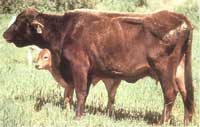CORRAL JOHNE'S DISEASE
Johne's (pronounced Yo-nee's) is caused by the bacterium Mycobacterium avium subspecies paratuberculosis (similar to tuberculosis). It is found in the small
intestines, lymph nodes, uterus, milk and feces.
Animals are usually infected in the first few months of life by ingesting contaminated milk, water or feed. Fetuses also can be infected in uterio.
It typically starts as an infection in calves, though visible signs do not generally appear until cattle are 2 to 5 years of age (and sometimes much older). The infection
is difficult to detect in its early stages. This bacterium causes an inflamed intestinal tract that results in severe weight loss and diarrhea and lower milk production.
Infected cattle frequently eat well, and look bright, however, they appear to be unthrifty. Body temperature may or may not be elevated. There is no cure for Johne's
disease once an animal becomes infected.
The disease is diagnosed by either blood or fecal tests, or at necropsy.
 Symtoms include chronic diarrhea and rapid weight loss. A 1997 national survey reported eight percent of beef herds tested had animals testing
positive for Johne's. In a survey of purebred cattle herds in Texas, more than 40% had test positive animals. Infected cows becme very thin and may have
bottle jaw.
Symtoms include chronic diarrhea and rapid weight loss. A 1997 national survey reported eight percent of beef herds tested had animals testing
positive for Johne's. In a survey of purebred cattle herds in Texas, more than 40% had test positive animals. Infected cows becme very thin and may have
bottle jaw.
Producers can take the lead in controlling Johne's in the Texas beef industry. Texas Animal Health Commission (TAHC) has special funds from
USDA-APHIS to help cattle raisers test their herds for Johne's and to develop management plans to reduce and prevent the disease.Time is limited
for this.
Volunteer testing also is a proactive in the interest of public health. The bacterium causing Johne's has been isolated from some patients with Crohn's
disease. Controlling John'es with good herd managment is essntial while further research determines if any relationship exists between the two disieases.
AND - A Healthy Herd = Higher Value
Johne's causes losses from premature culling, reduced milk production, lighter weaning and weights, lower fertility and increased heifer replacement costs.
Also, poor body condition lowers cull cow sale prices. Herds with negative tests may receive premiums as demand for these cattle increases. Over time,
management improvements will prevent new losses by reducing the risks of the disease. Buying cattle from test negative herds also can prevent
introducing Johne's into a herd.

Because the program is completely voluntary, producers are not required to report positive tests. Results can remain confidential.
Call us to learn how about testing and programs available.!




